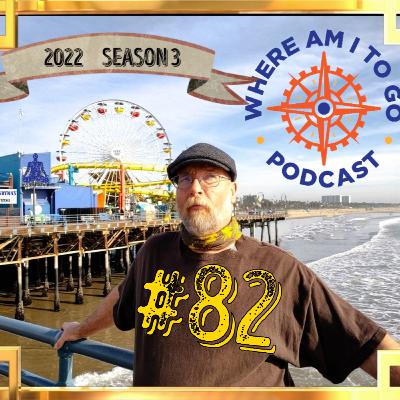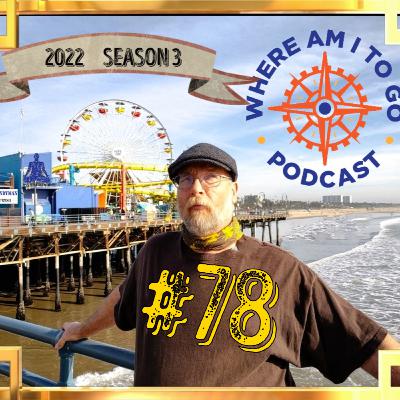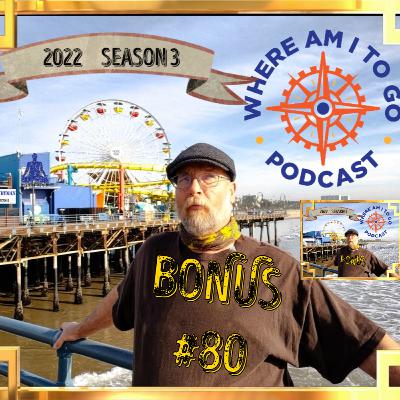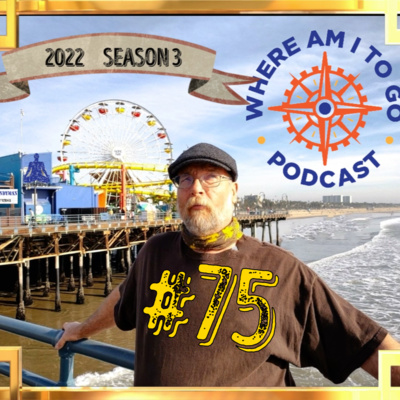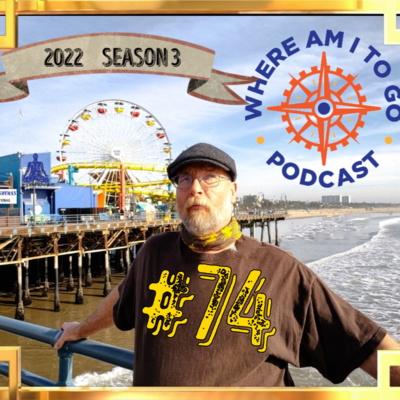Discover Where Am I To Go
Where Am I To Go

Where Am I To Go
Author: Loren Alberts
Subscribed: 5Played: 24Subscribe
Share
© Loren Alberts
Description
“The world is full of wonder. Get out and explore. And have a wonder-filled day”.
This is the way I've been starting the podcast I've been doing for the last four years, called “where am I to go”. I have primarily focused on museums, as museums are places that I find extremely interesting, and have since I was young. I feel that museums can connect us with our past in a way that no other form of media can. You can watch a movie, read a book, or watch documentaries on TV where you can get an idea of what history was, maybe how history happened and all of those may have a biased twist to them.
This is the way I've been starting the podcast I've been doing for the last four years, called “where am I to go”. I have primarily focused on museums, as museums are places that I find extremely interesting, and have since I was young. I feel that museums can connect us with our past in a way that no other form of media can. You can watch a movie, read a book, or watch documentaries on TV where you can get an idea of what history was, maybe how history happened and all of those may have a biased twist to them.
137 Episodes
Reverse
It All Started When . . .
Jude Cook spent his career in the design and sign industry. He began his own sign business over 40 years ago, first in Iowa and then moved Cook & Company Signmakers to Tucson. About nine years ago he began restoring Tucson's iconic neon signs.
Not only has Jude created and restored signs, he collected them too. His collection reached critical mass, filling the walls and the backyard of his sign business and took over the home front, too. It was time to share his collection with other sign lovers.
The Miracle of America Museum is a non-profit organization dedicated to the preservation of one of the largest collections of American history.
Gil Joanne Mangels founded the Miracle of America Museum in 1981.
Over the years the collection has grown and has received overwhelming support from the surrounding community and visitors that come from all over the world. Through the years the museum has had as many as 18,000 visitors annually from the entire 50 United States, all 10 Canadian provinces, and as many as 51 countries. The museum also attempts to give back to the local community and sponsors several educational tours for elementary and secondary level schools throughout Montana.
The current collection contains thousands of artifacts scattered throughout dozens of buildings and is open year round.
Hours of Operation: 9 AM to 5 PM daily
Admission Rates: Under 2 years: Free
Child 2 – 12 years: $5.00
Regular Admission: $10.00
Address: 36094 Memory Lane, Polson MT 59860
Phone: (406) 883-6804
AboutMontana is the birthplace of mountain flying. This museum seeks to interpret and preserve the history of mountain flying in Montana and the Northern Rockies. There are aircraft displays as well as interactive history displays.
Contact
MAILING ADDRESS
713 South Third Street
Missoula, MT 59801
CONTACT406-721-3644
FAX406-728-9280
Details
SEASON
Memorial day - Mid September
HOURS
Daily: 10:00am - 4:00pm
PAYMENT METHODS
Cash, Master Card, Personal Check (In State), Personal Check (Out Of State), Travelers Checks, Visa
RESERVATIONS
Reservations Accepted, Walk-Ins Welcome
DISCOUNTS
Senior Citizens
MIM began with a vision to create a musical instrument museum that would be truly global. Realizing most musical museums featured historic, primarily Western classical instruments, MIM’s founder Bob Ulrich (then CEO of Target Corporation) was inspired to develop a new kind of museum that would focus on the kind of instruments played every day by people worldwide. A focus on the guest experience shaped every aspect of the museum’s development. From the beginning, our goal has been to deliver a musical experience that is enriching, inspiring, interesting, and fun.
Today, MIM has a collection of more than 8,000 instruments from more than 200 world countries. The galleries reflect the rich diversity and history of many world cultures. But music and instruments also show us what we have in common—a thought powerfully expressed in our motto, music is the language of the soul.
The Museum’s exhibits and programs cover US military history from the Revolutionary War to the present War on Terror, with an emphasis on the interwar US Army (1920-41). By special arrangement with the Montana National Guard the Museum’s main exhibit building is located in Building T-316, Fort Missoula – the former headquarters for the Fort Missoula District of the US Covilian Conservation Corps. During the Great Depression of the 1930’s Army and civilian CCC personnel in Building T-316 oversaw the processing, equipping and training of over 40,000 CCC corpsmen.
The Mai Wah Museum is located in Butte, Montana, United States. Its mission is to document the history of Asian people in the Rocky Mountains. The museum is housed in the Wah Chong Tai building and Mai Wah Noodle Parlor building at 17 West Mercury Street.
Address: 17 W Mercury St, Butte, MT 59701
Hours:
Closed ⋅ Opens 10AM Tue
Phone: (406) 723-3231
The Marfa lights, also known as the Marfa ghost lights, have been observed near U.S. Route 67 on Mitchell Flat east of Marfa, Texas, in the United States. They have gained some fame as onlookers have attributed them to paranormal phenomena such as ghosts, UFOs, or will-o'-the-wisp.
The Marfa Lights—or Marfa Mystery Lights, as some call them—are a top reason to visit Marfa, drawing visitors from around the globe for a chance to see these unexplained phenomena. Accounts of the strange spectacle just east of Marfa began during the 19th century and continue to this day.
Ranchers, Native Americans, high school sweethearts, and famous meteorologists alike have reported seeing seemingly sourceless lights dance on the horizon southeast of town, an area that is nearly uninhabited and extremely difficult to traverse. The mystery lights are sometimes red, sometimes blue, sometimes white, and usually appear randomly throughout the night, no matter the season or the weather.
While the source of the mystery lights is still a point of contention, the show goes on. By most reports, they are whimsical and friendly; other witnesses maintain that they are ever distant and aloof; and some sources claim they zoom across the plains at terrifying speed, only to whip back around and dissolve before hitting the dumbstruck viewer.
The cynics will tell you that this so-called paranormal phenomenon is just the atmospheric reflections of cars and campfires at night. The mystics will tell you that’s hooey.
“What roads?” “Which campfires?”
The truth is, we just don’t know.
Everyone agrees it’s a mystery to be reckoned with.
There’s only one way to find out for yourself.
Each year, we celebrate with a Marfa Lights Festival, one of the most popular annual events in Marfa, with live music, food, and a parade. You can see Marfa Lights pictures on the Marfa Lights website and can read more about the Marfa Lights in the news on our Marfa media coverage page.
The official Marfa Lights Viewing Area is located 9 miles east of town on U.S. 90, towards Alpine. Bring an open mind and enjoy the great view!
The Marfa lights, also known as the Marfa ghost lights, have been observed near U.S. Route 67 on Mitchell Flat east of Marfa, Texas, in the United States. They have gained some fame as onlookers have attributed them to paranormal phenomena such as ghosts, UFOs, or will-o'-the-wisp.
The Marfa Lights—or Marfa Mystery Lights, as some call them—are a top reason to visit Marfa, drawing visitors from around the globe for a chance to see these unexplained phenomena. Accounts of the strange spectacle just east of Marfa began during the 19th century and continue to this day.
Ranchers, Native Americans, high school sweethearts, and famous meteorologists alike have reported seeing seemingly sourceless lights dance on the horizon southeast of town, an area that is nearly uninhabited and extremely difficult to traverse. The mystery lights are sometimes red, sometimes blue, sometimes white, and usually appear randomly throughout the night, no matter the season or the weather.
While the source of the mystery lights is still a point of contention, the show goes on. By most reports, they are whimsical and friendly; other witnesses maintain that they are ever distant and aloof; and some sources claim they zoom across the plains at terrifying speed, only to whip back around and dissolve before hitting the dumbstruck viewer.
The cynics will tell you that this so-called paranormal phenomenon is just the atmospheric reflections of cars and campfires at night. The mystics will tell you that’s hooey.
“What roads?” “Which campfires?”
The truth is, we just don’t know.
Everyone agrees it’s a mystery to be reckoned with.
There’s only one way to find out for yourself.
Each year, we celebrate with a Marfa Lights Festival, one of the most popular annual events in Marfa, with live music, food, and a parade. You can see Marfa Lights pictures on the Marfa Lights website and can read more about the Marfa Lights in the news on our Marfa media coverage page.
The official Marfa Lights Viewing Area is located 9 miles east of town on U.S. 90, towards Alpine. Bring an open mind and enjoy the great view!
The World Museum of Mining is a museum and memorial in Butte, Montana. Chartered in 1964 as a non-profit educational corporation, the Museum first opened its doors in July 1965. The site, an inactive silver and zinc mine named the Orphan Girl, includes 50 buildings on some 22 acres of land.
Lincoln Historic Site is unique in that it manages most of the historical buildings in the community of Lincoln. This most widely visited state monument in New Mexico is part of a community frozen in time—the 1870's and 1880's. Through a gift from the Hubbard Family Trust, the historic site now includes 17 structures and outbuildings, 7 of which are open year round and 2 more seasonally as museums. Most of the buildings in the community are representative of the Territorial Style of adobe architecture in the American Southwest.
Lincoln is a town made famous by one of the most violent periods in New Mexico history. Today's visitors can see the Old Lincoln County Courthouse with museum exhibits that recount the details of the Lincoln County War and the historic use of the "House" as store, residence, Masonic Lodge, courthouse, and jail. Walk in the footsteps of Billy the Kid, Pat Garrett, and other famous and infamous characters of the Wild West. Trace the events of 1878 through the Courthouse and the Tunstall Store, with their preserved 19th-century atmosphere.
Remarkably, the Tunstall Store contains displays of the original 19th-century merchandise in the original shelving and cases! Continue your walk through history by visiting El Torreón (a defensive tower built by native New Mexican settlers in the 1850s), the San Juan Mission Church, the Convento, Dr. Woods' House, the Montaño store and other historic structures throughout the town. The Anderson-Freeman Visitor's Center & Museum features historical exhibits in a timeline starting with American Indian prehistory and ending with the Lincoln County War. A 22 minute video about the Lincoln County War and the community is shown every half hour.
The importance of this community and the significance of the Bonito Valley in the prehistory and history of the Territory of New Mexico are interpreted within some of the 17 structures that comprise Lincoln Historic Site. These historic adobe and stone buildings are preserved as they were in the late 1800s and represent the factions involved in the Lincoln County War, 1878-1881.
The Franklin Auto Museum™, maintained by the Thomas H. Hubbard/H.H. Franklin Foundation, is located in Tucson Arizona. Founded by Thomas Hubbard, the museum is a means to continue his collection of classic Franklin automobiles, and to provide an opportunity to develop a comprehensive Franklin Museum covering all years of the company’s production.
Mr. Hubbard put into trust the following:
His entire Franklin automobile collection
An extensive library of Franklin Company research materials
His Aunt’s extensive collection of native American artifacts
A historical adobe home, museum and other buildings
A generous endowment sufficient to maintain and preserve the facility in Tucson
Tom’s intentions were for the trust to preserve and expand the cars, Indian artifacts and facilities to be complementary to the established southwestern site and architecture.
The automobile collection has grown to include additional representative examples of all Franklin automobiles. The H. H. Franklin Foundation is an educational museum of cars and displays. This is the center of Franklin history.
Welcome to Dwarf Car Museum!
Ernie Adams, originator of the dwarf car, has made a name for himself building Dwarf Race Cars and scaled down replicas of classic cars called Dwarf Car Cruisers. These handmade works of art now have a home in Maricopa, Arizona.
Early Years: Ernie Adams had a fascination with cars starting back in grade school. He would admire the cars of the time, drew them for school assignments and even built a wooden car as long as a crate box with steering and peanut butter jar lids for taillights. His mother would pull him through out his hometown of Harvard, Nebraska.
First Dwarf Car: The first Dwarf Car came to life in 1965 as a 28 Chevy two-door sedan made out of nine old refrigerators. Ernie began gathering the materials for this little car in 1962. By 1965 he had enough materials and an 18 hp Wisconsin motor to begin construction. With a homemade hacksaw made from a chair frame, hammer and a chisel, Ernie began construction. He had no idea what this would be the beginning of. Because this is the first Dwarf Car ever built, it is known as “GRANDPA DWARF.” This first Dwarf Car is kept in running order and is still driven today.
Dwarf Race Car: The first two Dwarf Race Cars were built in Dec. 1979 and early 1980. The Dwarf Race Car idea came about after Ernie Adams and Daren Schmaltz had attended motorcycle side hack races in Phoenix, Arizona. During the drive home, Ernie expressed concern that three-wheeled racers were to slow in the corners. He said they could improve considerably by adding a fourth wheel to help thru the corners. Ernie suggested that adding a car body would also help spectator appeal. The first Dwarf Car race took place at the Yavapai County Fair in Prescott, Arizona in September, 1983. There were 12 cars registered.
Dwarf Car Cruiser: After leaving the Dwarf Race Cars, Ernie had learned a lot about bending and shaping metal. He loved to see heads turn in admiration of the Dwarf Race Cars while being towed down the highway. Ernie knew it was time to change and put his metal shaping skills to the test. Now he wanted a fully dressed Dwarf Car with fenders, chrome, finished interior and most of all street legal and the Dwarf Car Cruiser was born.
Introduction
Named for Captain Henry W. Stanton, who was killed in a skirmish with the Apaches, Fort Stanton was built in 1855 by soldiers of the 1st Dragoon and the 3rd and 8th Infantry Regiments to serve as a base of operations against the Mescalero Apache Indians. It served as a military fortification through 1896. Built of local stone, the sturdy 1855 buildings have lasted to this day. The Fort was named for Captain Henry W. Stanton, killed fighting the Apaches in 1855 near present day Mayhill. Troops marched out from the Fort to search for and fight the Mescalero Indians during numerous campaigns from 1855 until the 1880’s.
The Military Years
The Fort was seized by Confederate forces in 1861. During the occupation, three Rebels were killed by Kiowa Indians while on patrol 50 miles north. After all supplies were moved to Mesilla, the Confederates abandoned the Fort, burning it as they left.
The Hospital Years
In 1896, with the Mescalero Apache settled on the nearby reservation and the surrounding area bustling with new communities, the Fort was abandoned by the Army and closed. In 1899, however, the US Public Health Service acquired the Fort as a tuberculosis hospital for the Merchant Marine. Selected for its healthful climate, it served some 5,000 sailor patients between 1899 and 1953, 1,500 of whom are buried in the Maritime Cemetery on a hillside overlooking the Fort. The patients lived in specially constructed tents, for fresh air and sunshine were the only known cures for tuberculosis.
During this time, many new buildings were constructed including a hospital, stables, new living quarters for the families stationed at Fort Stanton, and literally hundreds of tent-houses for the patients. The hospital was fairly self-sufficient, establishing a large farm on the nearby grounds with patients serving in the fields, as well as recreational activities like a golf course for the doctors, baseball fields and a theatre for the resident workers. The nearby cemetery grew to include veterans of other services as well as Merchant Marines, making it a place for current visitors to the site to engage in contemplative visitation.
CCC & Internment Camp
During the Great Depression, Fort Stanton was home to a CCC work camp, which later served as the internment site for German merchant seamen from the German luxury liner, S.S. Columbus, which was scuttled outside of New York to prevent its capture by the British. The German internees built a camp that included such amenities as gardens for fresh produce, a recreation hall, and a swimming pool in which “mini-Olympic” competitions were held with the local population. After war was declared with Germany and Japan, the Internment camp housed some German prisoners of war as well as a few Japanese internees. It was used during early WWII for several months as a refuge for a group of Japanese-American families threatened by mobs in their hometowns.
The Mini Time Machine was created from the imagination and dedication of Founders, Patricia and Walter Arnell. Pat’s fondness for miniatures began in the 1930’s, when as a young girl she received her first miniatures- a set of Strombecker wooden dollhouse furniture. It wasn’t until the Arnells moved to Tucson in 1979 that Pat began collecting in earnest. The Arnell’s became very active in the miniature community becoming recognized members and supporters of important organizations such as NAME (National Association of Miniature Enthusiasts) and IGMA (International Guild of Miniature Artisans). The collection grew, and the Arnells dreamed of a way to share it with more people. They envisioned an interactive space where the entertaining and educational aspects of the collection could be enjoyed by everyone- a place that would be enchanting, magical and provide a rich sensory experience.
The concept of “the mini time machine” was born out of the notion that a visitor would be seemingly transported to different eras by the stories and history of the pieces in the collection.
The Mini Time Machine Museum of Miniatures is a 501(c)(3) board-only nonprofit organization, classified as a private foundation with a long term goal of achieving public charity status. All proceeds from every sale, including admission, membership and merchandise go towards funding the museum’s operations.
The museum is dedicated to all who participate in the world of miniatures.
The Arizona Chapter of Safari Club International (AZSCI) has been promoting wildlife conservation and protecting hunters' rights for more than 40 years. We are Southern Arizona’s leading organization in hunter education courses, junior hunting camps and various conservation projects around Arizona. AZSCI has funded and provided volunteers for eight water catchments in region 5 of the state as well as several annual desert clean ups.
With a board of 14 hunters and an Executive Director, our chapter has been able to maintain an extensive partnership with the Arizona Game and Fish Department, furthering our abilities to promote hunter education and safety. Chapter headquarters are located in Tucson, AZ, which is home to the World Headquarters for Safari Club International and the International Wildlife Museum.
The chapter’s current membership is steadily growing, but we are always welcome to new people joining the chapter and getting involved with our mission programs. Please contact us today to join our chapter!
The chapter produces an annual banquet for our members, prospective members and sponsors at the Westin La Paloma Resort located in the foothills of Tucson. The Arizona Chapter of the Safari Club International is a non-profit organization and relies on members, donations and sponsors.
The original Smokey Bear Museum & Gift Shop. Established in 1960. Great selection of licensed gifts!
Podcast #80-S3 - Biosphere 2 In Review - Feb 11 2022
The Parade
This colorful, exciting Parade is presented each year and keeps the spirit of the first Parade back in 1925. Now known to be the largest Non-Motorized Parade in the country, It still achieves its success through the community's participation and the dedicated work of its members , volunteers and the generosity of the Sponsors.
The Museum
Take an afternoon to visit the museum. Find out about the wagons and historical collections showcased for all to enjoy. We also offer this in-person look at history to school groups and organizations. We've even had a spot on the Antique Roadshow. Come visit the Museum during the season.
History Relived
Take an afternoon to visit the "History Relived" March 5th & 6th . You will see almost 100 Wagons on display, model train exhibit, historic tucson business displays and a special feature of "The life of the Buffalo Soldier"
TITAN MISSILE MUSEUM HISTORY
The Titan Missile Museum is the only remaining Titan II site open to the public, allowing you to re-live a time when the threat of nuclear war between the U.S. and the former Soviet Union was a reality.
The Titan II was capable of launching from its underground silo in 58 seconds and could deliver a nine megaton thermonuclear warhead to its target more than 6,000 miles (approximately 10,000 km) away in less than thirty minutes. For more than two decades, 54 Titan II missile complexes across the United States stood “on alert” 24 hours a day, seven days a week, heightening the threat of nuclear war or preventing Armageddon, depending upon your point of view.
AN ARIZONA TREASURE
Proclaimed an Arizona Treasure by former Arizona Governor Janet Napolitano, the Titan Missile Museum is a unique facility that is comprised of two parts: The Count Ferdinand von Galen Titan Missile Museum Education and Research Center, and the Titan Missile National Historic Landmark. The Count Ferdinand von Galen Titan Missile Museum Education and Research Center is situated directly adjacent to the launch complex and houses an exhibit gallery, museum store, classroom, and an archival storage area.
The Titan Missile National Historic Landmark is former Titan II launch complex 571-7. This former operational missile site was originally part of the 571st Strategic Missile Squadron (SMS), 390th Strategic Missile Wing (SMW), Davis-Monthan Air Force Base (AFB), Arizona. It is the sole remaining Titan II Intercontinental Ballistic Missile (ICBM) complex of the 54 that were “on alert” during the Cold War between 1963 and 1987.
FROM SWORD TO PLOWSHARE
Launch complex 571-7 came off alert on November 11, 1982. Work to turn the missile site into a museum began in February of 1983, when Col Paul Comeaux, commander of the 390th SMW, contacted Charles Niblett, president of the Tucson Air Museum Foundation, the predecessor of the Arizona Aerospace Foundation. Colonel Comeaux proposed that the Foundation consider operating one of the soon-to-be-deactivated missile sites around Tucson as a museum.
Niblett contacted Col Hugh Matheson, USAF (Ret.), the former deputy commander for maintenance at the 390th SMW, and Lt Col Orville Doughty, USAF (Ret.), the former commander of the 390th Missile Maintenance Squadron. Together, these three men took on the tremendous task of convincing the Foundation Board, the Air Force, and the Tucson community that this project was both worthwhile and feasible.
By September of 1985, the necessary parties were in agreement and the paperwork was complete. The Air Force would retain ownership of missile site 571-7, but lease it to Pima County. Pima County, in turn, would sublease the site to the Foundation for the purpose of operating the Titan Missile Museum.
Before the Foundation could open the Titan Missile Museum, several modifications had to be made to the missile site. All of these modifications were made for the purpose of demonstrating that launch complex 571-7 is no longer an operational missile site. For example, before missile N-10 could go on display in the launch duct, holes were cut in each of its propellant tanks and in the heat shield of the Reentry Vehicle. Then the missile was displayed on the surface of the site for 30 days to allow satellites to confirm that it was no longer operational. After the missile was installed in the launch duct, the silo closure door was permanently placed in the half-open position (six huge concrete blocks prevent it from opening any further) and a large window was placed over the open portion of the launch duct to facilitate visitor and satellite viewing.
The Titan Missile Museum opened its doors to the public on May 21, 1986.
OVER 130 YEARS OF HISTORY
The Phoenix Police Museum is located at 180 W Jefferson Street, on the 1st floor of the Historic Phoenix City Hall. The museum highlights the history of the Phoenix Police Department from 1881, when Henry Garfias, was elected the first city marshal to the present.
OUR PURPOSE
To educate the public in the history of the Phoenix Police Department in historic and modern context in order to enhance the image of law enforcement; interact with our community through a positive learning environment; to promote and preserve the history of the department while building a closer relationship between our police department and our community. The Museum provides a public location for an educational museum which is free for all.
The Phoenix Police Museum is located at 17 South 2nd Avenue, on the 1st floor of the Historic Phoenix City Hall. The museum highlights the history of the Phoenix Police Department from 1881, when Henry Garfias, was elected the first city marshal to the present.














